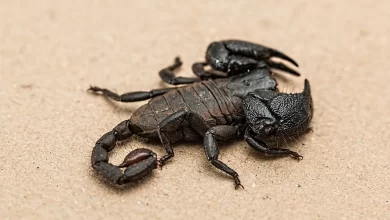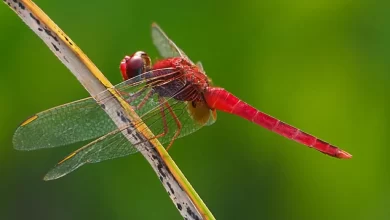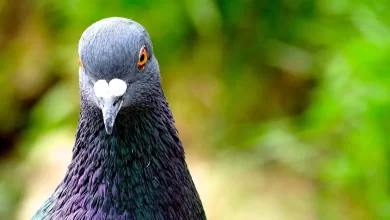Deer is a jungle mammal that lives in the woods. It can be found in various forms in Asia, Europe, and North America. A deer has four long legs and a short whitetail, and its skin is covered with white circular patches. The skin of certain Deer has white linings. A male deer’s head is adorned with horns, whereas a female deer’s head is devoid of horns. Deers explore the jungle in search of food, making them easy prey for other wild animals such as lions, tigers, and foxes. A deer is a mammal, which means it gives birth to babies. Deer are herbivores, meaning they eat grass, leaves, plants, and other jungle herbs. The deer population is on a decline due to the excessive hunting of this animal.
- There are over 43 species of Deer present in the world. They are distinguished by the presence of two large and two small hooves on each foot, as well as antlers are present in most male species and females of one species have antlers.
- Reindeer is the only species in which the females also grow antlers.
- Deers are found in almost every part of the world except Australia and Antarctica. They can be almost in forests that are mountainous, wet rainforest or even dry forests.
- The adult male Deer is called a Stag, or Buck. The female Deer is called a doe, and a young deer is called a fawn.
- The Eurasian Continent (which includes the Indian Subcontinent) has the most deer species globally, with Asia having the most. In comparison, the diversity of plant and animal species in Europe is lower.

- Canada has the largest population of giant deer, e.g., mule deer, elk, moose, whitetail deer, etc.
- The Chinese water has the most prominent teeth in all species and is about 52 mm in length(5.2 cm) that start from the upper jaw and acts as a sharp weapon against their hunters. They do not have antlers, and instead, they have long teeth.
- The moose is the world’s largest Deer (referred to as elk in Europe). They are found in North America in large numbers, extending from Alaska through Canada and the northeastern US. Moose have massive antlers with broad, open-palmed tips that extend beyond the “palm.” The moose that weighed 1,808 pounds was the largest ever recorded!
- Until the age of 8, male deer antlers get bigger each year. After they reach the age of maturity, it loses and gains new antlers every year. As they grow antlers, they also get covered by a layer of furry coat like thing called velvet.
- The velvet that surrounds the antler stubs provides the blood and oxygen that the antlers require to mature fully. The velvet antlers of the whitetail deer will be visible once they have fully grown. Deer rubs their backs and heads to remove the velvet from their pedicles.

- The gestation period of Deer is about seven and a half months or 222 days, and fawning starts in late May and lasts until June in some areas; otherwise, they can breed any time of the year. Twins are common, but only one fawn is usually born.
- Most deer fawns are born with white spots for survival reasons, with the exception of a few species, such as baby reindeer and moose, which are referred to as calves rather than fawns due to their larger size. Depending on the species, these creatures are born in a variety of colours and weigh between 6 and 16 kg.
- After the fawn is born, they can stand within 10 minutes and can start walking in 7 hours.
- All Deers, including the Whitetail deer, have four chambers stomachs and are ruminant (cud-chewing) animals. Deer tongue food to the back of their mouths and chew only enough to swallow it. A deer lies down to munch its cud after filling its paunch.
- Like many other mammals, Deer prepares for the winter by insulating their bodies better. To survive in the winters, deer change their habits. They are generally less active, with their metabolism falling by 50% or more, allowing them to conserve energy and eat less.

- Almost all deer species have a phenomenal jumping capability. They can jump over a distance of eight feet vertically and 25 feet horizontally.
- A deer fence would need to be at least nine feet tall to keep Deer out.
- In Pench National Park, Madhya Pradesh, India, a male sambar (Rusa unicolour) has huge preorbital glands; these animals are often referred to as “four-eyed deer.”
- A deer’s eyes are on the sides of the head, giving it a wide field of view. Even though Deer have less than half the number of cones in the eye as humans, deer can still distinguish among different colours and have a 310-degree vision.
- Deers can pick out short (blue) and middle (green) wavelength colours very well, but they’re less sensitive to long-wavelength colours such as orange and red.

- Deer, elk, moose, and caribou are taxonomically classified as mammals and belong to the Class Mammalia. They are then classified as part of the Order Artiodactyla, which includes all even-toed ungulates such as sheep, bison, pigs, and cows — indicating that they are related at this level.
- The majority of male white-tailed deer live to be about six years. Some live longer, while others live shorter. Females typically live two years longer than males. The longest-living White-tailed Deer was a doe in Georgia who lived for 22 years.
- They typically have a territory of 650 acres or one square mile in size. But keep in mind that the home ranges aren’t square. The core area is where the majority of the Deer will spend the majority of their time.
- A whitetail buck is considered mature at 3½ to 4½ years of age and in its prime up to 8½ years of age. On average, most bucks don’t live past 3½ years.
- A deer’s hearing abilities are not dissimilar to ours; in fact, they are superior to ours. They can effortlessly detect even the almost inaudible sounds. Deer, like humans, they hear intermediate frequencies between 4,000 and 8,000 hertz. Bawls, bleats, and grunts are all examples of deer vocalisations that are in this sound range.

- When a group of Deer congregates, most people refer to it as a herd; however, the group can also be referred to as a bunch, a mob, a parcel, or a range.
- According to a study, the female red Deer with larger brains tend to live longer.
- Deer tend to run at higher speed and have a running speed upto 90 km/hr compared to Tiger’s 50 km/hr, but they still become a victim of Tiger. Because Dear believes he is weaker than Tiger and keeps looking back, Deer loses his speed and courage and therefore falls prey to Tiger.
- The population of Deer living on earth is close to 30 million.
- The resting heart rate in Deer is between 40 and 50 beats per minute. In contrast, humans resting heart ranges between 40 and 100 beats per minute.

- Aside from sound, deer can communicate with one another through smell, sight, and even taste. A deer’s tail is like a dog’s and can send signals. The glands can be found between their hooves, where they leave a scent as they walk, as well as on their eyes, between their ears, inside their nose, and just above their tail.
- Some species of Deer’s practices polygamy, and some of them practice monogamy.
- Reindeer is the only species of Deer that is domesticated.
- The largest antlers are found on moose, the largest deer species! Mule-deer and caribou are two other North American animals with antlers.
- The largest antlers species among deer are found on moose, which is also the largest deer species! Mule-deer and caribou are two other North American animals with antlers. The Deer is one of the main animals found in ancient cave paintings.

- Some species of Deer’s are on the endangered list now, and some species will be declared endangered soon.
- According to a recent study, Deer Mothers can respond to Infant Distress Vocalizations.
- The Pudu deer species is the worlds smallest deer species, with the southern pudu being slightly larger than the northern pudu. It has stocky with short and slender legs. This species is around 32 to 44 cm (13 to 17 inches) in height at the shoulder and up to 85 cm (33 in) in length.
- The origins of the surname Deer can be traced back to the Anglo-Saxon tribes of England. It is derived from a beloved early member of the family or as a term of endearment. Deer is also a surname derived from the animal deer.
References
- Britannica.com
- Quora.com
- a-z-animals.com
- Ansci.wisc.edu
- Totaltails.com
- Nativeanimalrescue.org
- facstaff.uwa.edu
- now.tufts.edu
- Madison.com
- Wikipedia-Preorbital Gland
- Deer.psu.edu
- Tpwd.texas.gov
- Realtree.com
- Realtree.com
- Grandviewoutdoors.com
- Cam.ac.uk
- Twitter.com
- pbs.org
- Wikipedia-Cave Paining
- Journals.uchicago.edu






